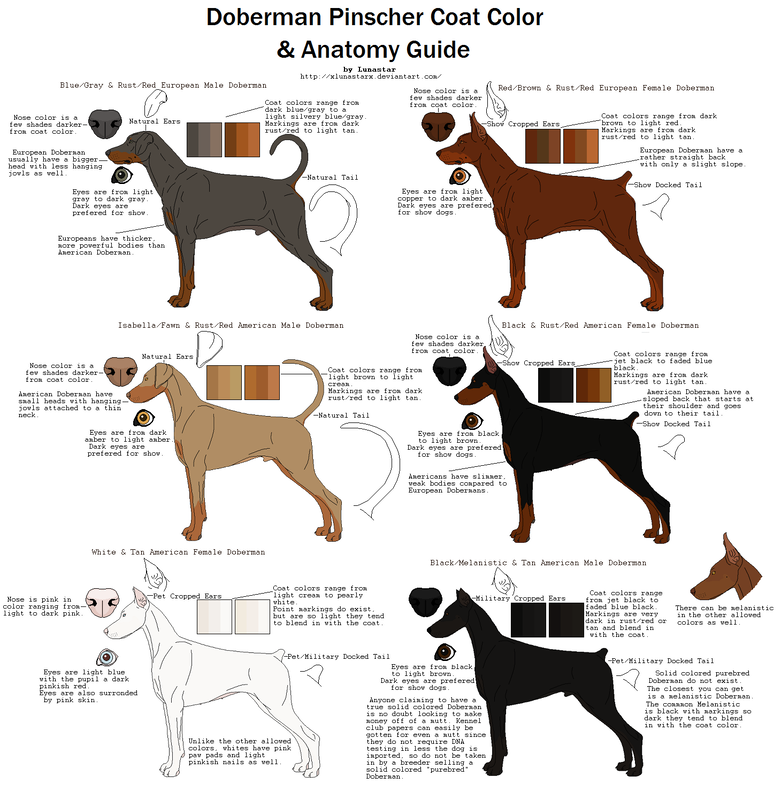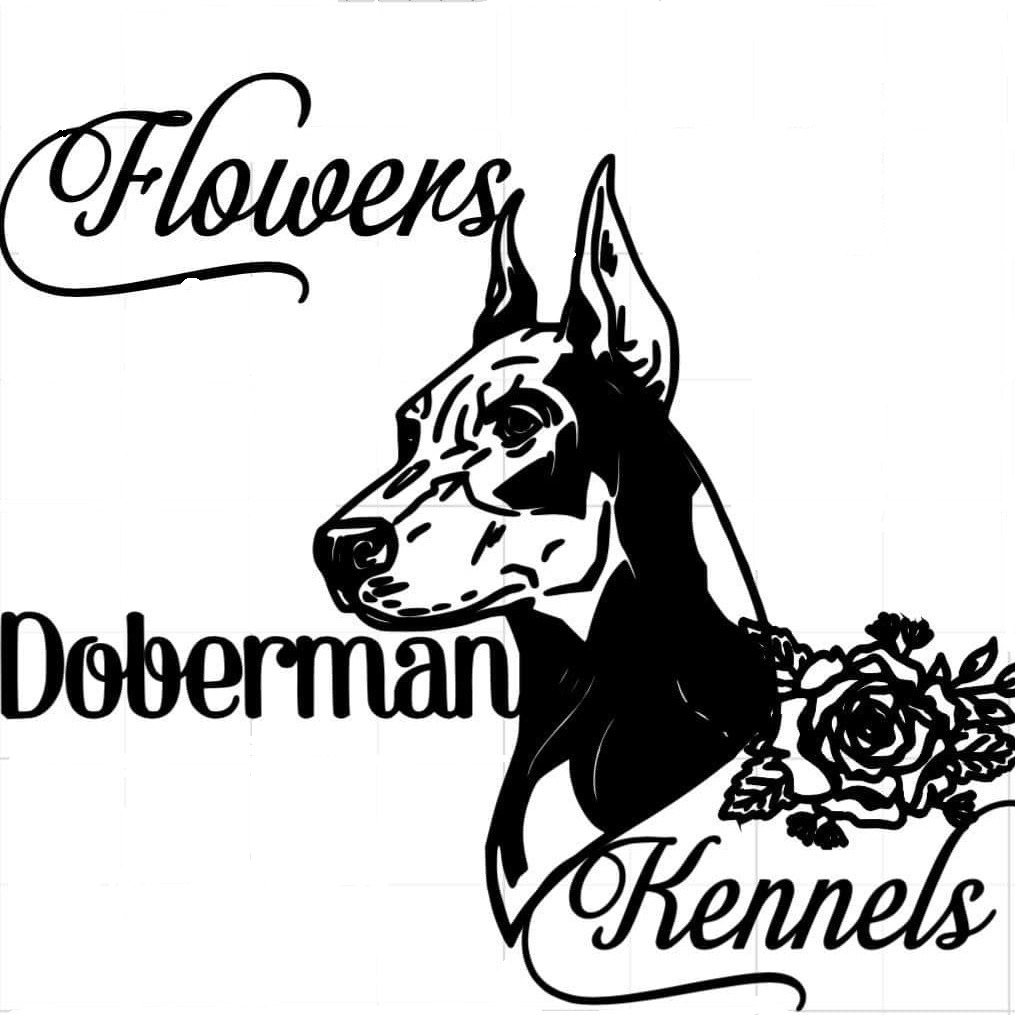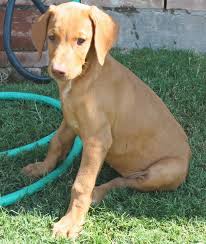The Melanistic Doberman
|
Melanistic Doberman are not “rare”, rather they are just different genes at play. Melanism in Doberman is due to a genetic mutation. There are three potential causes of a "solid" Doberman;
The E Lotus is the Masked Magician The Em mutation is fairly rare, occurring in a limited gene pool of dogs. The Em on the E lotus causes a melanistic mask (muzzle or face). Normally, a Doberman has two normal gene, represented as N/N (N for normal). When there is a mutation it is represented as em/N or em/em. A dog with em/N will be a standard color but be able to pass on the em gene to 50% of its offspring. In Doberman this displays as a dark muzzle and darker black markings on legs and feet. Not every dark muzzle/pencilling has a Em mutation though! A dog with em/em will be "affected" for the melanistic mask and will pass at least one em gene on to all of its offspring. “Extreme masking can also "hide" tan points. The K & A Lotuses Genetically, all dogs simplified have either a solid black coat pigment or red/brown coat pigment (phaeomelanin). A solid black is called eumelanin. "Whether a dog has a solid eumelanin (black) coat or a coat with red/tan markings (caused by phaeomelanin) depends almost entirely on the K locus. K consists of three alleles:
Genetically, all dogs simplified have either a solid black coat pigment or red/brown coat pigment (phaeomelanin). A solid black is called eumelanin. "Whether a dog has a solid eumelanin (black) coat or a coat with red/tan markings (caused by phaeomelanin) depends almost entirely on the K locus. K consists of three alleles:
Because black is dominant, a dog with even just one KB gene will be solid black. A dog with two ky genes (i.e. homozygous for ky) will be able to show tan markings. These tan markings are determined by another locus, A (ASIP). So basically, a genotype of ky/ky allows a dog to show whatever it has on the A locus. A Kb/ky or KB/KB dog may be genetically tan-pointed or sable on the A locus, but won't be able to show those markings because of its dominant black allele/s. Dominant black dominates the whole of the A locus, but it can be modified by other genes, such as liver, dilution, greying, and merle. All of these will alter the way a dominant black dog looks, but the one thing they cannot do is add phaeomelanin (red) to the coat. The only way phaeomelanin can be added to the coat of a dog with the dominant black gene is through the e gene (E locus) - recessive red. This turns a dominant black dog (or indeed, any dog) into a solid red dog with black nose pigment. ... Most black dogs have the dominant black gene, but there's also another, less common gene that can cause solid black too - recessive black (a on the A locus)." The A lotus consists of four alleles:
http://www.doggenetics.co.uk/black.htm |

Melanism is a Genetic MutationMelanism is a genetic mutation and not a variation of coat color. Research in mice and cats has been proven it to be genetic.
Studies on some wild melanistic animals has shown that they're healthier and longer lived. The reasoning behind this is they are more difficult to spot thus having a greater chance at survival. A melanistic prey animal is more difficult for a predator to find. A melanistic predator is more difficult to spot making it more successful at hunting. The exact reason to their better health is not well understood but may be linked to lower stress levels and better immune health. 4)Melanisim is correlated with better vitamin D synthesis. Melanism is a genetic mutation and not a variation of coat color. Research in mice and cats have been proven to be genetic. Studies on some wild melanistic animals has shown that they're healthier and longer lived. The reasoning behind this speculation is they are more difficult to spot thus having a greater chance at survival; a melanistic prey animal is more difficult for a predator to find, a melanistic predator is more difficult to spot making it more successful at hunting. The exact reason for their better health is not well understood but may be linked to lower stress levels and better immune health. Melanism is correlated with better vitamin D synthesis which boosts the immune system. One example of melanism and improved health is melanistic wolves have better immunity to distemper. There was a significant difference between wolves carrying one gene for melanism and those who had two; "differences among color genotypes in the Yellowstone population includes highest annual survival, lifespan, and lifetime reproductive success for black heterozygotes and lowest survival, reproductive success, and frequency for black homozygotes ". https://academic.oup.com/mbe/article/35/5/1190/4913657 https://science.sciencemag.org/content/334/6060/1275.abstract There are many different alleles responsible for the same color or pattern. Allele frequency varies within different populations in a breed. Many off standard coat variations are naturally occurring, though not often expressed. Recessive red (sometimes called clear reds) and, melanistic, dominant blacks, and extreme masking are all variations possible within the Doberman genetics but aren't often expressed. https://www.ncbi.nlm.nih.gov/pmc/articles/PMC6816562/ Fun Fact: Doberman are one of a few breeds that carry only the tan point allele on the A lotus. That means all Doberman are born genetically tan pointed - though this can be overridden by the K Dominant Black or E lotus Extreme Masking as the points are visible in sunlight. http://www.doggenetics.co.uk/tan.html |
***All melanistic doberman can be registered through the akc, you are required to provide photos of the puppy and email them to colors@akc.org.***
The "Clear Red" aka "Stag Red" Doberman
|
The E lotus is responsible for many coat variations we see. In Doberman the back, red, blue or fawn top coat has a tan pointed base (aka pointed markings). The ee/ee mutation turns off the top coat color and shows the base coat. This is called recessive red. The stag red, often called “clear red”, Doberman is genetically ee/ee on the E lotus gene. These dogs are not rare nor breed standard. They're simply different genetics at play. The genes responsible for the black or red coat are "turned off" exposing the under coat which makes up the tan points.
|
These recessive red/clear/stag red Doberman are variations seen in the coat spectrum. The recessive reds are throwbacks to the German Pinscher and Manchester Terriers used during the breed's creation. The DPCA doesn't condone the breeding of off-standard colors. With these off standard dogs the gene pool from the carriers can be valuable for the breed's diversity. They have retained some older genetics that should be considered for genetic diversity. Those dogs of standard color and good representation of the breed can be used to lower the COI in lines that are heavily inbred.
***The akc dosent currently reconize this color mutation, however after providing photos of the puppy the puppy will be registard as "fawn"***

